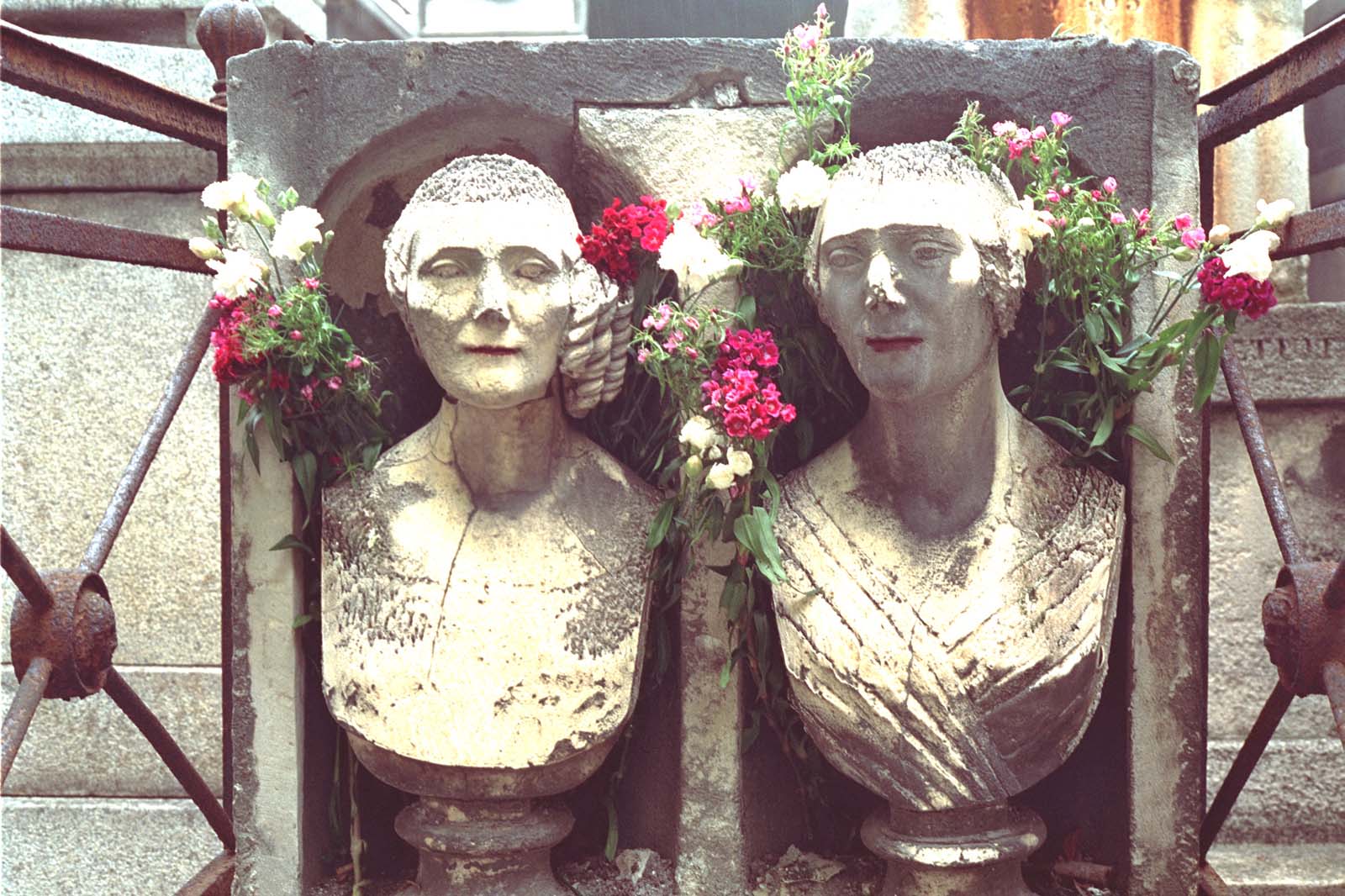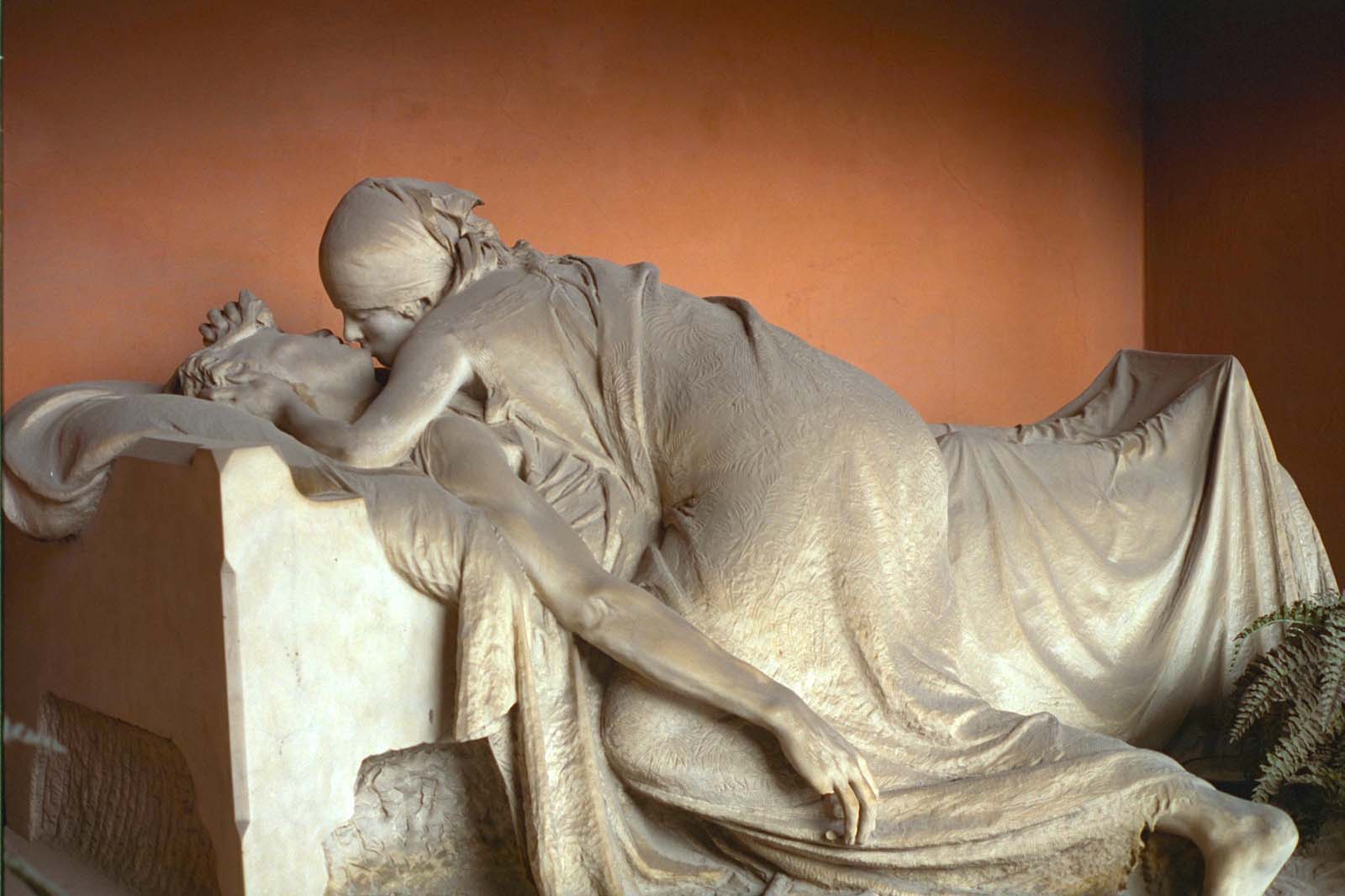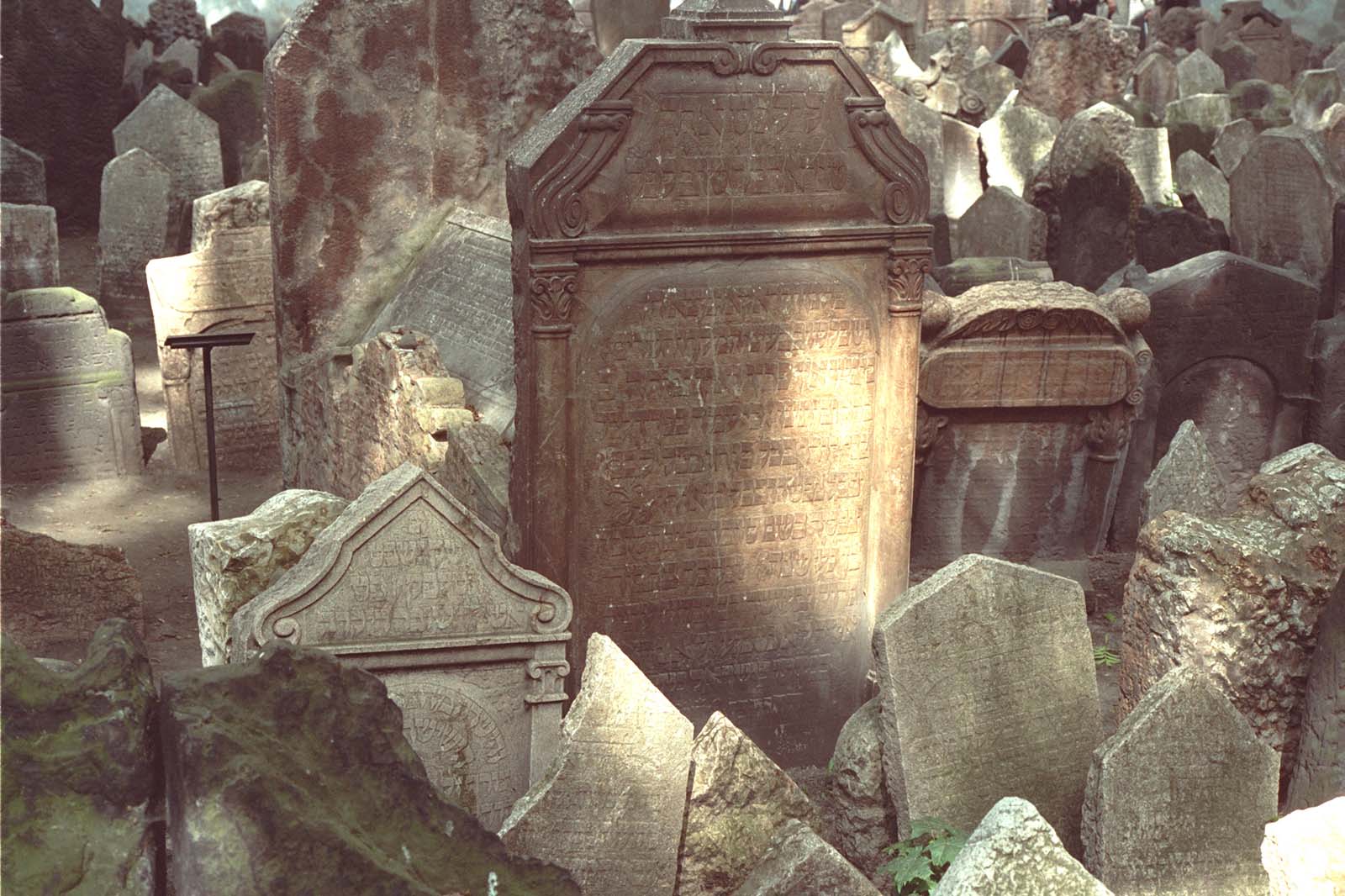Beautiful Death: Art of the Cemetery
While based in Paris, I roamed the cemeteries of Europe. Over a period of two years I took over ten thousand photographs of cemeteries including Pere Lachaise, Montparnasse and Montmartre in Paris, the cemeteries of London and village churchyards in England, the Jewish Cemetery in Prague, and cemeteries across France, Spain, Portugal and Italy. I sought out the strange, affecting beauty of tombs, the poignant signs of loss, mourning and separation and the aspirations to afterlife and the beautiful reunion awaiting in the beyond.
The visual impact of Pere Lachaise was immediate—monumental tombs lining broad cobblestoned streets shaded by huge trees. Impressed by the beauty of the individual tombs and monuments, the art of the cemetery intrigued me more than the historical records of the deceased. I am more interested in the intimate and telling details of commemoration and the psychological mind-set that spawned such glorious creativity. My photographs seek to evoke the emotions expressed in the cemeteries through the art.
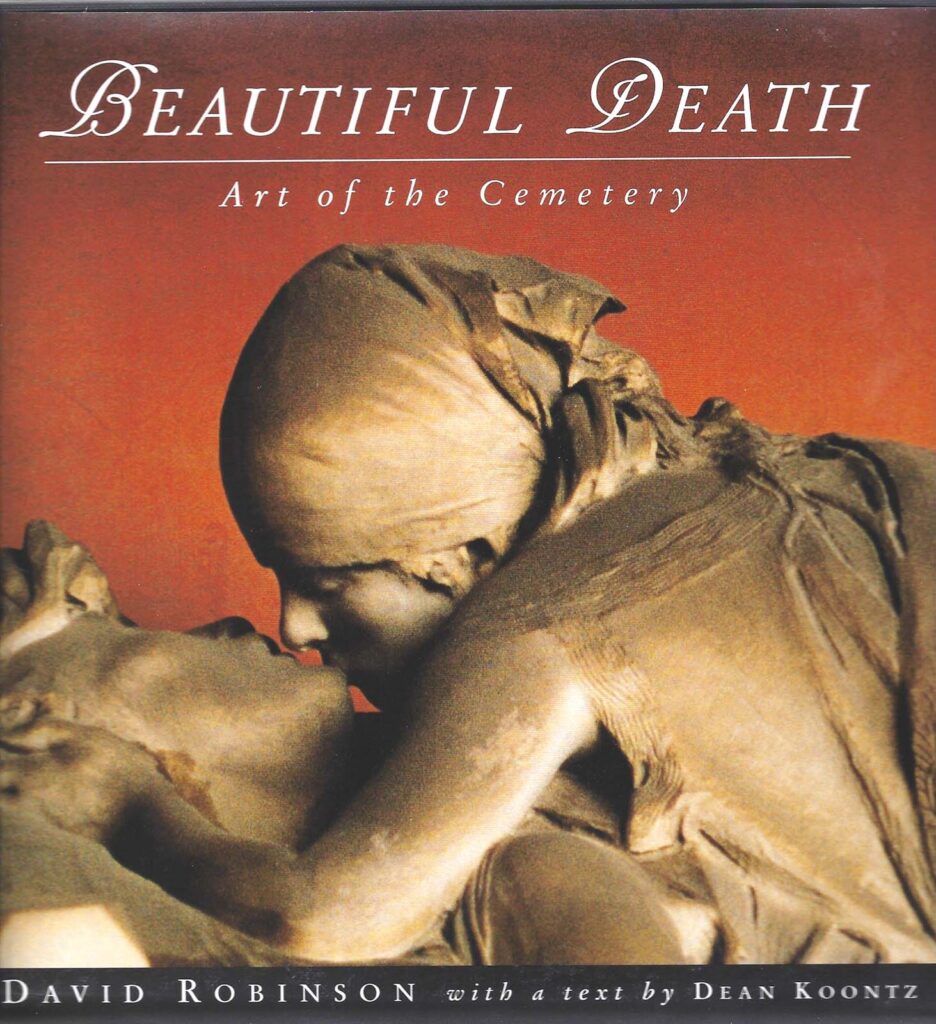
Beautiful Death: Art of the Cemetery
115 photographs with an introduction by Dean Koontz
Penguin Studio, New York 1996
Exhibition Prints
Silver Gelatin prints 16″ x 20″ (20″ x 24″ mounted)
Cibachrome prints 16″ x 20″ (20″ x 24″ mounted)
Cibachromes are high quality color prints made from a color transparency enlarged directly onto reversal paper. The paper is unique in that dyes are incorporated into the emulsion on the paper instead of being formed chemically. This gives exceptional color image brilliance. Cibachrome prints are made directly from slides. A dye destruction print made in this way is more permanent than a chromogenic print.
Note: The Cibachrome process was discontinued in 2011, so I am no longer making color prints from the Beautiful Death series.
Beautiful Death: Art of the Cemetery
While based in Paris, I roamed the cemeteries of Europe. Over a period of two years I took over ten thousand photographs of cemeteries including Pere Lachaise, Montparnasse and Montmartre in Paris, the cemeteries of London and village churchyards in England, the Jewish Cemetery in Prague, and cemeteries across France, Spain, Portugal and Italy. I sought out the strange, affecting beauty of tombs, the poignant signs of loss, mourning and separation and the aspirations to afterlife and the beautiful reunion awaiting in the beyond.
The visual impact of Pere Lachaise was immediate—monumental tombs lining broad cobblestoned streets shaded by huge trees. Impressed by the beauty of the individual tombs and monuments, the art of the cemetery intrigued me more than the historical records of the deceased. I am more interested in the intimate and telling details of commemoration and the psychological mind-set that spawned such glorious creativity. My photographs seek to evoke the emotions expressed in the cemeteries through the art.

115 photographs, with an introduction by Dean Koontz
Penguin Studio, New York 1996
Exhibition Prints
Silver Gelatin prints, 16″ x 20″
(20″ x 24″ mounted)
Cibachrome prints, 16″ x 20″
(20″ x 24″ mounted)
Cibachromes are high quality color prints made from a color transparency enlarged directly onto reversal paper. The paper is unique in that dyes are incorporated into the emulsion on the paper instead of being formed chemically. This gives exceptional color image brilliance. Cibachrome prints are made directly from slides. A dye destruction print made in this way is more permanent than a chromogenic print.
Note: The Cibachrome process was discontinued in 2011, so I am no longer making color prints from the Beautiful Death series.
Dead Artists
For artists, maybe unknown or dismissed and impoverished in life, death is often the turning point in their fame. When I was living in Paris, photographing in cemeteries, it seemed natural for me to search out the graves of artists I admired. I started with Van Gogh and soon broadened my search to include all the impressionists and most of the post-impressionists whose work I was admiring in the Paris museums. I end with Picasso. It was not always easy to find the artists’ graves; biographies always record their deaths, sometimes in great detail, but often neglect the burial. I had to go to the Musèe d’Orsay to do research in their top floor newspaper archives in order to find the graves (it’s much easier now but was much more fun then.)

Dead Artists
Dead Artists
For artists, maybe unknown or dismissed and impoverished in life, death is often the turning point in their fame. When I was living in Paris, photographing in cemeteries, it seemed natural for me to search out the graves of artists I admired. I started with Van Gogh and soon broadened my search to include all the impressionists and most of the post-impressionists whose work I was admiring in the Paris museums. I end with Picasso. It was not always easy to find the artists’ graves; biographies always record their deaths, sometimes in great detail, but often neglect the burial. I had to go to the Musèe d’Orsay to do research in their top floor newspaper archives in order to find the graves (it’s much easier now but was much more fun then.)

Saving Graces
Many European cemeteries are highly maintained sculpture gardens. Scattered among the sculptures are shockingly sensual sculptures of women. They are perfect, idealized creations: young, gorgeous, elaborately posed and beautifully sculpted. Often naked or barely clothed, and consumed with grief for the dead, they are both a stunning and eerie presence among the other gravestones. “David Robinson’s exquisite photographs reveal the ghostly beauty and mystery of these lifelike sculptures.”
In her forward, Joyce Carol Oates explores the many implications of these grief-stricken, extremely provocative figures—our obsession with morality, the rituals of mourning, the conflation of death and the erotic, the perfect female form as a male fantasy and symbol of status. She writes, “Saving Graces is an assemblage of strikingly beautiful photographs.”
“The distinguished American photographer David Robinson’s account of his discovery of these ‘graces’ in European cemeteries reads like a mystery in which the photographer, led by his camera, is a kind of detective. Who are these beautiful women? Who are they mourning? What is their symbolic significance?”

Saving Graces
102 photographs with an introduction by Joyce Carol Oates
W.W. Norton, New York and London 1995, reissued 2000
Exhibition Prints
Silver Gelatin prints 11″ x 14″ (16″ x 2o” mounted)
Saving Graces
Many European cemeteries are highly maintained sculpture gardens. Scattered among the sculptures are shockingly sensual sculptures of women. They are perfect, idealized creations: young, gorgeous, elaborately posed and beautifully sculpted. Often naked or barely clothed, and consumed with grief for the dead, they are both a stunning and eerie presence among the other gravestones. “David Robinson’s exquisite photographs reveal the ghostly beauty and mystery of these lifelike sculptures.”
In her forward, Joyce Carol Oates explores the many implications of these grief-stricken, extremely provocative figures—our obsession with morality, the rituals of mourning, the conflation of death and the erotic, the perfect female form as a male fantasy and symbol of status. She writes, “Saving Graces is an assemblage of strikingly beautiful photographs.”
“The distinguished American photographer David Robinson’s account of his discovery of these ‘graces’ in European cemeteries reads like a mystery in which the photographer, led by his camera, is a kind of detective. Who are these beautiful women? Who are they mourning? What is their symbolic significance?”

102 photographs, with an introduction by Joyce Carol Oates
W.W. Norton, New York and London 1995, reissued 2000
Exhibition Prints
Silver Gelatin prints 11″ x 14″
(16″ x 2o” mounted)
Italian Reflections
This series of impressionistic images reflected in water and glass began in Rome with a reflection taken in a Piazza Navona puddle nestled among the cobblestones. The photographs taken throughout Italy from Venice to Sicily create impressionistic images that look to be compilations or manipulated but which are natural photographs available to anyone with the inclination to notice.
This series produced two books; When I approached Anthony Burgess to write an introduction, after looking at my photographs, he chose instead to write a novel inspired partially by my photographs and which I then illustrated. (See below)
Dye transfer prints of the Italian Reflections have been widely exhibited, including the Weston Gallery in Carmel California and the International Center of Photography in New York. These dye transfer prints are in major collections, including The Museum of Fine Arts, Boston and the Bibliotheque Nationale in Paris (see below).
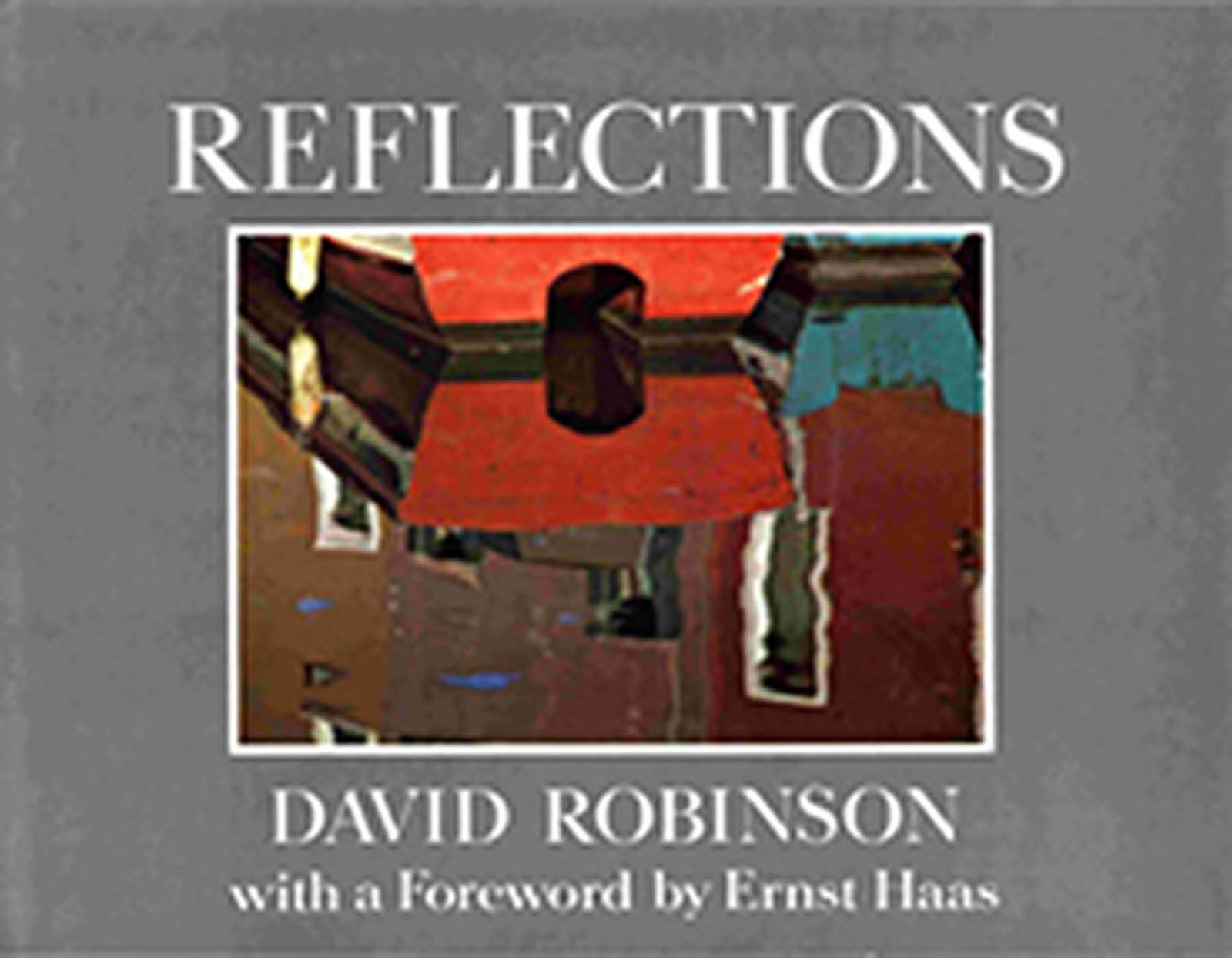
Reflections
112 photographs with an introduction by Ernst Haas
Holt, Rinehart & Winston (US) / Secker & Warburg (UK), 1978
Beard’s Roman Women / Rome in the Rain
A novel by Anthony Burgess, inspired by and illustrated with my Italian Reflections photographs.
McGraw Hill (US) / Hutchinson of London (UK), 1976
Exhibition Prints
Dye Transfer prints 16” x 20” (20” x 24” mounted)
Dye Transfer is a full-color photographic printing process in which three layers of dye—cyan, magenta, and yellow—are applied sequentially, by hand, to one emulsion layer. The process involves many steps and painstaking alignment of each dye layer, and as a result dye transfers are rare. They are very stable, and, when executed correctly, they allow the photographer exceptional control over the final color balance. (Museum of Modern Art, NY)
Note: The Dye Transfer Process was discontinued in 1992, so I am no longer making prints of the Italian Reflections series.
Italian Reflections
This series of impressionistic images reflected in water and glass began in Rome with a reflection taken in a Piazza Navona puddle nestled among the cobblestones. The photographs taken throughout Italy from Venice to Sicily create impressionistic images that look to be compilations or manipulated but which are natural photographs available to anyone with the inclination to notice.
This series produced two books; When I approached Anthony Burgess to write an introduction, after looking at my photographs, he chose instead to write a novel inspired partially by my photographs and which I then illustrated. (See below)
Dye transfer prints of the Italian Reflections have been widely exhibited, including the Weston Gallery in Carmel California and the International Center of Photography in New York. These dye transfer prints are in major collections, including The Museum of Fine Arts, Boston and the Bibliotheque Nationale in Paris (see below).

112 photographs, with an introduction by Ernst Haas
Holt, Rinehart & Winston (US) / Secker & Warburg (UK), 1978
Beard’s Roman Women / Rome in the Rain
A novel by Anthony Burgess, inspired by and illustrated with my Italian Reflections photographs.
McGraw Hill (US) / Hutchinson of London (UK), 1976
Exhibition Prints
Dye Transfer prints 16” x 20”
(20” x 24” mounted)
Dye Transfer is a full-color photographic printing process in which three layers of dye—cyan, magenta, and yellow—are applied sequentially, by hand, to one emulsion layer. The process involves many steps and painstaking alignment of each dye layer, and as a result dye transfers are rare. They are very stable, and, when executed correctly, they allow the photographer exceptional control over the final color balance. (Museum of Modern Art, NY)
Note: The Dye Transfer Process was discontinued in 1992, so I am no longer making prints of the Italian Reflections series.
SoHo Walls: Beyond Graffiti
I spent 10 years photographing walls in SoHo. When I first went to SoHo, it was because I was interested in art, and that is where the art was. What made SoHo so special for me was the intensity of what was happening in that compact, twenty-block area filled with artists’ lofts. Art is not a 9-to-5 job, there is no turning it off, and it is not restricted to galleries or formal settings. Art was in the SoHo air, its energy palpable, spilling out of the lofts onto the streets and onto the walls. Whether paper or paint or stencil, in SoHo I found a unique style of wall art — beyond graffiti as we usually know it.
Wall art is almost entirely an ephemeral. It may last for a week or a month, during which other artists will react to it, paint over it, alter it. Or it may last only a few hours and then be gone forever. The SoHo Walls series is a gallery and record of contemporary art in a unique time and place.

SoHo Walls: Beyond Graffiti
97 photographs with an essay by the author
Thames and Hudson, New York and London 1990
Writing on the Walls
Catalogue of a group exhibition at the Casa di Giulietta in Verona Italy; 60 photographs by 4 photographers; David Robinson, Aaron Siskind, Salvatore Mancini and Leland Rice.
Essays by Charles Traub and Roberta Valtorta.
World Action Project, Verona Italy 1990
Exhibition Prints
Cibachrome prints 16″ x 20″ (20″ x 24″ mounted)
Cibachromes are high quality color prints made from a color transparency enlarged directly onto reversal paper. The paper is unique in that dyes are incorporated into the emulsion on the paper instead of being formed chemically. This gives exceptional color image brilliance. Cibachrome prints are made directly from slides. A dye destruction print made in this way is more permanent than a chromogenic print.
Note: The Cibachrome process was discontinued in 2011, so I am no longer making prints from the SoHo Walls series.
SoHo Walls: Beyond Graffiti
I spent 10 years photographing walls in SoHo. When I first went to SoHo, it was because I was interested in art, and that is where the art was. What made SoHo so special for me was the intensity of what was happening in that compact, twenty-block area filled with artists’ lofts. Art is not a 9-to-5 job, there is no turning it off, and it is not restricted to galleries or formal settings. Art was in the SoHo air, its energy palpable, spilling out of the lofts onto the streets and onto the walls. Whether paper or paint or stencil, in SoHo I found a unique style of wall art — beyond graffiti as we usually know it.
Wall art is almost entirely an ephemeral. It may last for a week or a month, during which other artists will react to it, paint over it, alter it. Or it may last only a few hours and then be gone forever. The SoHo Walls series is a gallery and record of contemporary art in a unique time and place.

97 photographs, with an essay by the author
Thames and Hudson, New York and London 1990
Writing on the Walls
Catalogue of a group exhibition at the Casa di Giulietta in Verona Italy; 60 photographs by 4 photographers: David Robinson, Aaron Siskind, Salvatore Mancini and Leland Rice. Essays by Charles Traub and Roberta Valtorta. World Action Project, Verona Italy 1990
Exhibition Prints
Cibachrome prints 16″ x 20″ (20″ x 24″ mounted)
Cibachromes are high quality color prints made from a color transparency enlarged directly onto reversal paper. The paper is unique in that dyes are incorporated into the emulsion on the paper instead of being formed chemically. This gives exceptional color image brilliance. Cibachrome prints are made directly from slides. A dye destruction print made in this way is more permanent than a chromogenic print.
Note: The Cibachrome process was discontinued in 2011, so I am no longer making prints from the SoHo Walls series.




